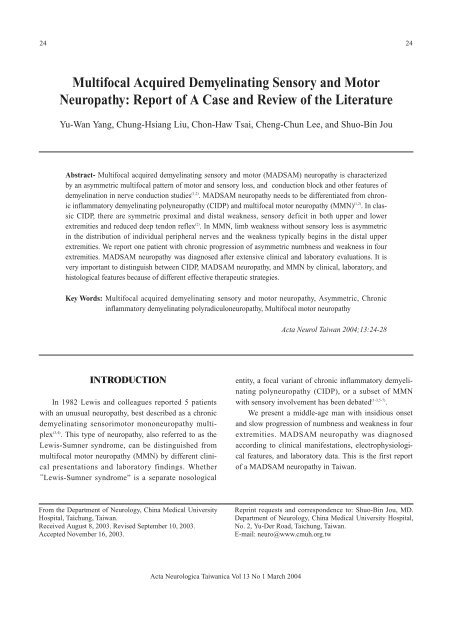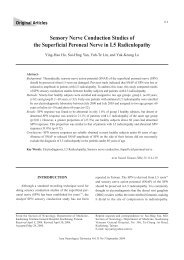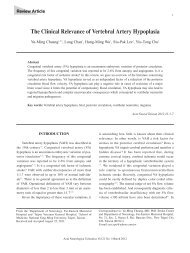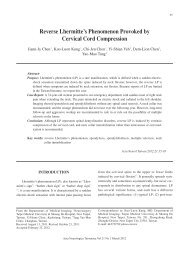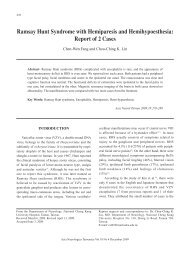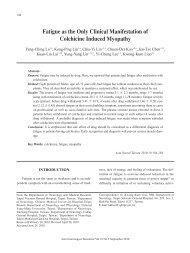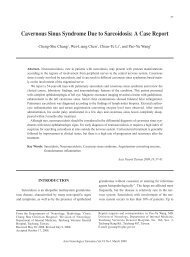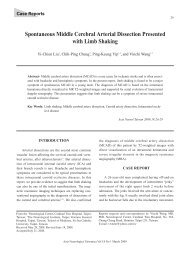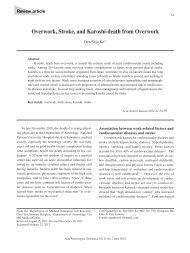Multifocal Acquired Demyelinating Sensory and Motor Neuropathy ...
Multifocal Acquired Demyelinating Sensory and Motor Neuropathy ...
Multifocal Acquired Demyelinating Sensory and Motor Neuropathy ...
Create successful ePaper yourself
Turn your PDF publications into a flip-book with our unique Google optimized e-Paper software.
24<br />
24<br />
<strong>Multifocal</strong> <strong>Acquired</strong> <strong>Demyelinating</strong> <strong>Sensory</strong> <strong>and</strong> <strong>Motor</strong><br />
<strong>Neuropathy</strong>: Report of A Case <strong>and</strong> Review of the Literature<br />
Yu-Wan Yang, Chung-Hsiang Liu, Chon-Haw Tsai, Cheng-Chun Lee, <strong>and</strong> Shuo-Bin Jou<br />
Abstract- <strong>Multifocal</strong> acquired demyelinating sensory <strong>and</strong> motor (MADSAM) neuropathy is characterized<br />
by an asymmetric multifocal pattern of motor <strong>and</strong> sensory loss, <strong>and</strong> conduction block <strong>and</strong> other features of<br />
demyelination in nerve conduction studies (1,2) . MADSAM neuropathy needs to be differentiated from chronic<br />
inflammatory demyelinating polyneuropathy (CIDP) <strong>and</strong> multifocal motor neuropathy (MMN) (1,2) . In classic<br />
CIDP, there are symmetric proximal <strong>and</strong> distal weakness, sensory deficit in both upper <strong>and</strong> lower<br />
extremities <strong>and</strong> reduced deep tendon reflex (2) . In MMN, limb weakness without sensory loss is asymmetric<br />
in the distribution of individual peripheral nerves <strong>and</strong> the weakness typically begins in the distal upper<br />
extremities. We report one patient with chronic progression of asymmetric numbness <strong>and</strong> weakness in four<br />
extremities. MADSAM neuropathy was diagnosed after extensive clinical <strong>and</strong> laboratory evaluations. It is<br />
very important to distinguish between CIDP, MADSAM neuropathy, <strong>and</strong> MMN by clinical, laboratory, <strong>and</strong><br />
histological features because of different effective therapeutic strategies.<br />
Key Words: <strong>Multifocal</strong> acquired demyelinating sensory <strong>and</strong> motor neuropathy, Asymmetric, Chronic<br />
inflammatory demyelinating polyradiculoneuropathy, <strong>Multifocal</strong> motor neuropathy<br />
Acta Neurol Taiwan 2004;13:24-28<br />
INTRODUCTION<br />
In 1982 Lewis <strong>and</strong> colleagues reported 5 patients<br />
with an unusual neuropathy, best described as a chronic<br />
demyelinating sensorimotor mononeuropathy multiplex<br />
(3,4) . This type of neuropathy, also referred to as the<br />
Lewis-Sumner syndrome, can be distinguished from<br />
multifocal motor neuropathy (MMN) by different clinical<br />
presentations <strong>and</strong> laboratory findings. Whether<br />
Lewis-Sumner syndrome” is a separate nosological<br />
entity, a focal variant of chronic inflammatory demyelinating<br />
polyneuropathy (CIDP), or a subset of MMN<br />
with sensory involvement has been debated (1-3,5-7) .<br />
We present a middle-age man with insidious onset<br />
<strong>and</strong> slow progression of numbness <strong>and</strong> weakness in four<br />
extremities. MADSAM neuropathy was diagnosed<br />
according to clinical manifestations, electrophysiological<br />
features, <strong>and</strong> laboratory data. This is the first report<br />
of a MADSAM neuropathy in Taiwan.<br />
From the Department of Neurology, China Medical University<br />
Hospital, Taichung, Taiwan.<br />
Received August 8, 2003. Revised September 10, 2003.<br />
Accepted November 16, 2003.<br />
Reprint requests <strong>and</strong> correspondence to: Shuo-Bin Jou, MD.<br />
Department of Neurology, China Medical University Hospital,<br />
No. 2, Yu-Der Road, Taichung, Taiwan.<br />
E-mail: neuro@www.cmuh.org.tw<br />
Acta Neurologica Taiwanica Vol 13 No 1 March 2004
25<br />
CASE REPORT<br />
This 38-year-old man experienced diminished sensation<br />
in left h<strong>and</strong> in January 2001. He denied any systemic<br />
diseases or toxic exposure. There was no pain,<br />
cramping, or fasciculations in his h<strong>and</strong>s. The numbness<br />
spread from distal to proximal parts of left upper limb,<br />
<strong>and</strong> then to the other limbs. Four months later, the<br />
patient had asymmetric weakness in his distal four<br />
extremities, which interfered with his walking.<br />
Neurological examination in July 2001 revealed asymmetric<br />
distal weakness with mild muscle wasting. The<br />
motor examination using MRC scale revealed 4+ in right<br />
deltoid; 4- in right biceps, triceps, dorsal <strong>and</strong> palmar<br />
interossei <strong>and</strong> left biceps, triceps, brachioradialis, flexor<br />
carpi radialis, <strong>and</strong> abductor pollicis brevis; 4 in the other<br />
muscles. The patient had difficulty walking on toes <strong>and</strong><br />
heels. <strong>Sensory</strong> examination revealed impaired pinprick<br />
<strong>and</strong> light touch sensations in the medial part of the bilateral<br />
forearms, <strong>and</strong> the first, second, third, <strong>and</strong> fourth fingers,<br />
<strong>and</strong> the medial part of the left leg. Triceps <strong>and</strong><br />
ankle jerks were depressed <strong>and</strong> biceps, brachioradialis,<br />
<strong>and</strong> knee jerks were absent. The nerve conduction studies<br />
revealed asymmetric motor <strong>and</strong> sensory conduction<br />
slowing, motor conduction block, prolonged or absent F-<br />
waves, absent H-reflex, <strong>and</strong> reduced amplitude of compound<br />
muscle action potentials (CMAPs), <strong>and</strong> sensory<br />
nerve action potentials (SNAPs) (Tables 1 <strong>and</strong> 2). The<br />
CSF study was normal, except for a marked elevation of<br />
protein (170mg/dl). The protein electrophoresis <strong>and</strong><br />
immunoelectrophoresis of CSF <strong>and</strong> blood failed to show<br />
monoclonal gammopathy. Serum anti-GM1 antibody<br />
titer (449.1 BTU) was below low-cutting (1000 BTU:<br />
cut off). The anti-nuclear antibody <strong>and</strong> antibody for HIV<br />
were negative. Fasting blood glucose was 84 mg/dl;<br />
HbA1c, 5.4% (Normal: 4.6 to 6.5%); ESR 7 mm/1hr.<br />
(Normal: 0-15 mm/1hr).<br />
MADSAM neuropathy was diagnosed. The patient<br />
received prednisolone (50 mg per day), <strong>and</strong> symptoms<br />
were markedly improved after 4 months treatment. The<br />
motor examination after one year’s prednisolone treatment<br />
showed MRC 4+ in right deltoid, biceps, triceps,<br />
dorsal <strong>and</strong> palmar interossei <strong>and</strong> left biceps, triceps, brachioradialis,<br />
flexor carpi radialis, <strong>and</strong> abductor pollicis<br />
brevis. The patient could walk with a swagger but had<br />
difficulty walking on toes <strong>and</strong> heels. Repeated nerve<br />
conduction study repeated in December 2002 (Table 3)<br />
revealed mildly improved conduction velocities of motor<br />
nerves.<br />
DISCUSSION<br />
In chronic acquired demyelinating polyneuropathy, it<br />
is important to differentiate MADSAM neuropathy from<br />
Table 1. Nerve conduction studies in April, 2001<br />
Nerve Stimulation Recording Amplitude Latency Conduction F-wave H-reflex<br />
stimulated site site (motor = mV; (msec) velocity latency latency<br />
sensory = µV) (m/sec) (msec) (msec)<br />
RT LT RT LT RT LT RT LT RT LT<br />
Median (m) Wrist APB 12.1 9.7 3.6 3.8 NR 37.5<br />
Elbow APB 4.3 7.1 9.5 8.4 39 52.2<br />
Ulnar (m) Wrist ADM 9.6 9.3 3.2 3.1 36.1 30.8<br />
Below elbow ADM 4.3 6.2 7.7 7.8 51.1 50<br />
Above elbow ADM 4.3 5.1 9 9.3 61.5 53.3<br />
Median (s) Wrist Index finger 8.6 5 2.5 3 60 48.7<br />
Ulnar (s) Wrist Little finger NR 1.1 NR 2.8 NR 45.4<br />
Tibial (m) Ankle AH 9.7 8.7 5.1 4.8 64.1 70.9 41.5 44.5<br />
Popliteal fossa AH 3.8 2.3 15.8 16 37.9 35<br />
Peroneal (m) Ankle EDB 5.9 4.7 4.3 6.1 56.8 41.6<br />
Below fibula EDB 3.5 2.9 12.3 13.8 39.4 42.9<br />
Lateral popliteal fossa EDB 3.1 2 14.4 15.8 38.1 40<br />
Sural (s) Calf Posterior ankle 4.6 9.1 3.1 3 45.2 46.7<br />
m: motor study; s: sensory study; RT: right; LT: left; NR: no response; APB: abductor pollicis brevis; ADM: abductor digiti minimi; AH: abductor<br />
hallucis; EDB: extensor digitorum brevis.<br />
Note: All sensory latencies are peak latencies. F-wave <strong>and</strong> H-reflex latencies represent the minimum latency.<br />
Acta Neurologica Taiwanica Vol 13 No 1 March 2004
26<br />
Table 2. Nerve conduction studies in July, 2001<br />
Nerve Stimulation Recording Amplitude Latency Conduction F-wave H-reflex<br />
stimulated site site (motor = mV; (msec) velocity latency latency<br />
sensory = µV) (m/sec) (msec) (msec)<br />
RT LT RT LT RT LT RT LT RT LT<br />
Median (m) Wrist APB 5.8 8.2 3.8 3.4 36.6 39.5<br />
Elbow APB 1.4 4.7 12.5 8.2 27.4 47.9<br />
Ulnar (m) Wrist ADM 6.1 5.5 3.4 2.9 45.8 40.5<br />
Below elbow ADM 2.3 4.5 9.1 7.2 40.4 51.2<br />
Above elbow ADM 2.2 3.8 10.5 8.8 57.1 50<br />
Median (s) Wrist Index finger 4.1 1.7 2.8 2.9 53.6 51.7<br />
Ulnar (s) Wrist Little finger 0.8 1.3 2.3 2.5 56.5 52<br />
Tibial (m) Ankle AH 6.2 4.1 4 4.5 66.2 57.8 NR NR<br />
Popliteal fossa AH 1.2 0.9 15.5 17.4 35.9 31<br />
Peroneal (m) Ankle EDB 4.7 3.1 3.7 4.6 76.3 89.6<br />
Below fibula EDB 1.6 1.4 12.2 13.4 37.6 36.4<br />
Lateral popliteal fossa EDB 1.1 0.8 14.8 16 30.8 30.8<br />
Sural (s) Calf Posterior ankle 3.7 5.3 3.2 3.4 43.8 41.2<br />
Abbreviations as in Table 1.<br />
Table 3. Nerve conduction studies in December, 2002<br />
Nerve Stimulation Recording Amplitude Latency Conduction F-wave H-reflex<br />
stimulated site site (motor = mV; (msec) velocity latency latency<br />
sensory = µV) (m/sec) (msec) (msec)<br />
RT LT RT LT RT LT RT LT RT LT<br />
Median (m) Wrist APB 10.8 8.7 3.7 3.9 38.2 32.2<br />
Elbow APB 9.9 8.4 10.1 8.6 36.7 50<br />
Ulnar (m) Wrist ADM 10 9.4 3.2 3.2 38.6 33.7<br />
Below elbow ADM 3.8 8.1 8.7 8 42.7 49<br />
Above elbow ADM 3.6 7.7 10.5 9.8 44.4 44.4<br />
Median (s) Wrist Index finger 9.8 7 2.8 2.8 53.6 53.6<br />
Ulnar (s) Wrist Little finger NR NR NR 2.8 NR 48.2<br />
Tibial (m) Ankle AH 10.9 9.2 4.2 4.5 54.3 60 46.8 51.8<br />
Popliteal fossa AH 6.4 5.4 14.6 16 38.5 34.8<br />
Peroneal (m) Ankle EDB 3.3 2.7 4.2 5 58.8 58.8<br />
Below fibula EDB 2.6 1.9 12.7 12.7 37.1 40.9<br />
Lateral popliteal fossa EDB 2.3 1.8 15.2 15.3 32 30.8<br />
Sural (s) Calf Posterior ankle 1.6 5.9 3.6 3.4 38.9 41.2<br />
Abbreviations as in Table 1.<br />
CIDP <strong>and</strong> MMN (8) . Classic CIDP is characterized by a<br />
symmetric proximal <strong>and</strong> distal phenotype. When diagnostic<br />
criteria for CIDP were initially proposed, weakness<br />
of proximal <strong>and</strong> distal limbs was a m<strong>and</strong>atory inclusion<br />
criterion (2,9,10) . CIDP may begin insidiously <strong>and</strong><br />
evolves slowly, attaining its maximum severity after several<br />
months or even a year or longer (2) . CIDP was separated<br />
from acute inflammatory polyneuropathy by<br />
Austin in 1958 based on a chronic relapsing course,<br />
enlargement of nerves, <strong>and</strong> responsiveness to steroids (11) .<br />
The symptoms <strong>and</strong> signs of CIDP may be asymmetrical<br />
initially <strong>and</strong> have ascending involvements. But it usually<br />
progresses slowly to symmetric weakness, loss of deep<br />
tendon reflex, <strong>and</strong> impaired sensation in h<strong>and</strong>s <strong>and</strong><br />
feet (2,12,13) . Antecedent infections can be identified far less<br />
regularly in patients with CIDP than those with acute<br />
inflammatory demyelinating polyneuropathy (AIDP) (14) .<br />
Elevated concentration of CSF protein <strong>and</strong> evidence of<br />
demyelination on electrodiagnostic examination are<br />
found in most patients with CIDP (1,2,12) . The pathophysiology<br />
of CIDP is still unclear, but an autoimmune mechanism<br />
is proposed due to the likely responsiveness of<br />
immunomodulating treatments of CIDP (2,9,10,12,13,15) . The<br />
efficacy of corticosteroids (2,13,16) , plasma exchange (17,18) ,<br />
Acta Neurologica Taiwanica Vol 13 No 1 March 2004
27<br />
<strong>and</strong> IVIg (19-21) in treating CIDP have been demonstrated in<br />
several r<strong>and</strong>omized controlled trials.<br />
In contrast to CIDP, multifocal motor neuropathy<br />
(MMN) shows an asymmetrical weakness <strong>and</strong> muscle<br />
atrophy, typically in the distribution of individual peripheral<br />
nerves without sensory involvement (1-3,12,13,22-24) . MMN<br />
with a clinical picture of mononeuritis multiplex <strong>and</strong><br />
electrophysiologic evidence of persistent motor conduction<br />
block (MCB) (1,2,12,13) is considered an acquired<br />
immune-mediated demyelinating motor polyneuropathy<br />
(12,13,15) . The diagnosis of MMN usually relies on the<br />
presence of MCBs. High titers of anti-GM1 antibodies<br />
are often detected in the serum of patients with<br />
MMN (2,12,13) . IVIg (1,2,15) <strong>and</strong> cyclophosphamide (1,2,13,14) are<br />
effective treatment for the majority of patients with<br />
MMN.<br />
Lewis <strong>and</strong> his colleagues reported in 1982 five<br />
patients exhibiting different clinical <strong>and</strong> neurophysiologic<br />
features from 35 patients with classical CIDP (4) . The<br />
major features that separate MADSAM neuropathy from<br />
typical CIDP are the electrophysiological findings (3) <strong>and</strong><br />
favorable responses to plasma exchange, prednisone, or<br />
IVIg. Similar to CIDP, CSF protein content is increased<br />
in 60-80% of patients with MADSAM neuropathy (1-3,5,7,14) .<br />
On the other h<strong>and</strong>, polyclonal IgM antibodies against<br />
GM1 may be detected in 40-80% of MMN patients, but<br />
difficult to detect in CIDP <strong>and</strong> MADSAM neuropathy<br />
(1-3,5,7,14)<br />
. In MADSAM neuropathy, MMN, <strong>and</strong> CIDP, the<br />
nerve conduction studies show features of demyelination,<br />
such as conduction block, temporal dispersion, prolonged<br />
distal latencies, slow conduction velocities, <strong>and</strong><br />
absent or prolonged F-wave latencies in one or more<br />
motor nerves (1-3) . MADSAM neuropathy is different from<br />
MMN due to sensory nerves are involved <strong>and</strong> different<br />
from CIDP due to conspicuous asymmetric multiple<br />
nerves involvement.<br />
60-70% of patients with MADSAM neuropathy<br />
showed improvement after IVIg treatment, lasting for<br />
several months. Such response is similar to the those of<br />
CIDP <strong>and</strong> MMN (1-3,5,7,14,15) . The alternative treatment was<br />
corticosteroids. Unlike MMN but similar to CIDP, 50-<br />
70% of patients with MADSAM neuropathy have shown<br />
improvement with corticosteroid treatment (1,2,5,7) .<br />
However, only less than 3% of patients with MMN<br />
responded to corticosteroid (22) .<br />
Our patient had asymmetric multifocal demyelinating<br />
neuropathy with conduction block in nerve conduction<br />
study, elevated CSF protein content, low anti-GM1<br />
antibody titer, <strong>and</strong> a good response to steroid. These features<br />
fulfill the diagnostic criteria for MADSAM neuropathy.<br />
Prednisolone treatment seemed to be effective.<br />
It is important to distinguish MADSAM neuropathy<br />
from CIDP <strong>and</strong> MMN.<br />
REFERENCES<br />
1. Saperstein DS, Amato AA, Wolfe GI, et al. <strong>Multifocal</strong><br />
acquired demyelinating sensory <strong>and</strong> motor neuropathy: the<br />
Lewis-Sumner syndrome. Muscle Nerve 1999;22:560-6.<br />
2. Saperstein DS, Katz JS, Amato AA, et al. Clinical spectrum<br />
of chronic acquired demyelinating polyneuropathies.<br />
Muscle Nerve 2001;24:311-24.<br />
3. Parry GJ. Are multifocal motor neuropathy <strong>and</strong> Lewis-<br />
Sumner syndrome distinct nosologic entities Muscle<br />
Nerve 1999;22:557-9.<br />
4. Lewis RA, Sumner AJ, Brown MJ, et al. <strong>Multifocal</strong><br />
demyelinating neuropathy with persistent conduction block.<br />
Neurology 1982;32:958-64.<br />
5. Gorson KC, Ropper AH, Weinberg DH, et al. Upper limb<br />
predominant, multifocal chronic inflammatory demyelinating<br />
polyneuropathy. Muscle Nerve 1999;22:758-65.<br />
6. Lewis RA. <strong>Multifocal</strong> motor neuropathy <strong>and</strong> Lewis-<br />
Sumner syndrome: two distinct entities. Muscle Nerve<br />
1999;22:1738-9.<br />
7. Oh SJ, Claussen GC, Kim DS. <strong>Motor</strong> <strong>and</strong> sensory demyelinating<br />
mononeuropathy multiplex (multifocal motor <strong>and</strong><br />
sensory demyelinating neuropathy): a separate entity or a<br />
variant of chronic inflammatory demyelinating polyneuropathy<br />
J Periph Nerv Syst 1997;2:362-9.<br />
8. Van den Berg-Vos RM, Van den Berg LH, Franssen H, et<br />
al. <strong>Multifocal</strong> inflammatory demyelinating neuropathy: a<br />
distinct clinical entity Neurology 2000;54:26.<br />
9. Barohn RJ, Kissel JT, Warmolts JR, et al. Chronic inflammatory<br />
demyelinating polyradiculoneuropathy. Clinical<br />
characteristics, course, <strong>and</strong> recommendations for diagnostic<br />
criteria. Arch Neurol 1989;46:878-84.<br />
10. Dyck PJ, Lais AC, Ohta M, et al. Chronic inflammatory<br />
polyradiculoneuropathy. Mayo Clin Proc 1975;50:621-37.<br />
Acta Neurologica Taiwanica Vol 13 No 1 March 2004
28<br />
11. Austin JH. Observations on the syndrome of hypertrophic<br />
neuritis (the hypertrophic interstitial radiculoneuropathies).<br />
Medicine 1956;35:187.<br />
12. S<strong>and</strong>er HW, Latov N. Research criteria for defining<br />
patients with CIDP. Neurology 2003;60:S8-S15.<br />
13. Koski CL. Therapy of CIDP <strong>and</strong> related immune-mediated<br />
neuropathies. Neurology 2002;59:S22-7.<br />
14. Victor M, Ropper AH. Diseases of the peripheral nerves.<br />
In: Adams <strong>and</strong> Victor’s Principles of Neurology 2001:<br />
1410-3.<br />
15. Van Doorn PA, Garssen MP. Treatment of immune neuropathies.<br />
Curr Opin Neurol 2002;15:623-31.<br />
16. Dyck PJ, O’Brien PC, Oviatt KF, et al. Prednisone<br />
improves chronic inflammatory demyelinating polyradiculoneuropathy<br />
more than no treatment. Ann Neurol 1982;<br />
11:136-41.<br />
17. Dyck PJ, Daube J, O’Brien PC, et al. Plasma exchange in<br />
chronic inflammatory demyelinating polyradiculoneuropathy.<br />
N Engl J Med 1986;314:461-5.<br />
18. Hahn AF, Bolton CF, Pillary N, et al. Plasma-exchange<br />
therapy in chronic inflammatory demyelinating polyneuropathy:<br />
a double-blind, sham-controlled, cross-over study.<br />
Brain 1996;1055-66.<br />
19. Dyck PJ, Litchy WJ, Kratz KM, et al. A plasma exchange<br />
versus immune globulin infusion trial in chronic inflammatory<br />
demyelinating polyradiculoneuropathy. Ann Neurol<br />
1994;36:838-45.<br />
20. Hahn AF, Bolton CF, Zochodne D, et al. Intravenous<br />
immunoglobulin treatment in chronic inflammatory<br />
demyelinating polyneuropathy. A double-blind, placebocontrolled,<br />
crossover study. Brain 1996;119:1067-77.<br />
21. Mendell JR, Barohn RJ, Kissel JT, et al. Intravenous<br />
immunoglobulin in untreated patients with chronic inflammatory<br />
demyelinating polyneuropathy. Neurology 2000;<br />
54(Suppl 3):A212.<br />
22. Auer RN, Bell RB, Lee MA. <strong>Neuropathy</strong> with onion bulb<br />
formations <strong>and</strong> pure motor manifestations. Can J Neurol<br />
Sci 1989;16:194-7.<br />
23. Chaudhry V. <strong>Multifocal</strong> motor neuropathy. Semin Neurol<br />
1998;18:73-81.<br />
24. Chaudhry V, Corse AM, Cornblath DR, et al. <strong>Multifocal</strong><br />
motor neuropathy: response to human immune globulin.<br />
Ann Neurol 1993;33:237-42.<br />
Acta Neurologica Taiwanica Vol 13 No 1 March 2004


